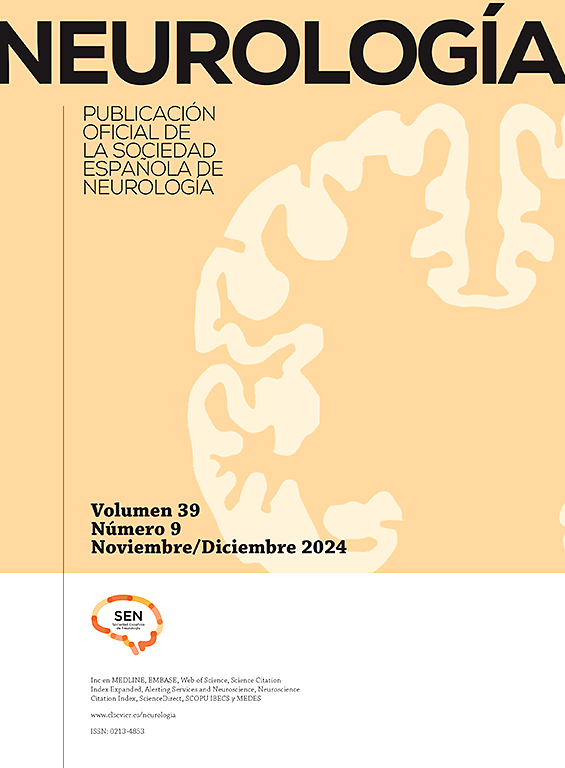Impacto asistencial de la electroencefalografía realizada durante la guardia de Neurofisiología Clínica en un hospital de tercer nivel
IF 3.1
4区 医学
Q2 CLINICAL NEUROLOGY
引用次数: 0
Abstract
Introduction
The electroencephalogram (EEG) is a useful tool in the diagnosis of pathologies such as non-convulsive status epilepticus (NCSE) or brain death (BD), cardiac arrest (CA), and status epilepticus (SE) treatment monitoring. In addition, it provides irreplaceable information depending on the time it is performed, as is the case with the diagnosis of epilepsy after a first epileptic seizure (ES) or to differentiate these from non-epileptic paroxysmal events (NEPE). Its usefulness is maintained outside the usual working day, but it is not available in many centers.
Subjects and methods
Retrospective observational study based on the clinical history of 86 patients who underwent an on-call EEG (ocEEG) at our hospital during 2020.
Results
One hundred two records requested by Intensive Care (41.1%), Neurology (37.3%), Pediatrics (17.6%) or other services (4%) were made. Suspected NCSE represented 56.7%, followed by treatment monitoring in EE (21.6%). The ME accounted for only 6.9% of the total. The ocEEG avoided potential iatrogenesis in a 56.3% of cases with therapeutic implications, allowed to treat 27.58% of patients who would have remained without treatment until the conventional EEG. An increase in the level of care was required in only 22.2% of all cases. The ocEEG was anticipated a mean of 31.6 h to the next conventional EEG that would have been available.
Conclusions
The availability of ocEEG is beneficial in terms of diagnosis, therapy, and hospital management, advancing decision-making and avoiding iatrogenesis. Its availability should become widespread.
在三级医院神经生理学临床病房进行脑电图对护理的影响
脑电图(EEG)是诊断非惊厥性癫痫持续状态(NCSE)或脑死亡(BD)、心脏骤停(CA)和癫痫持续状态(SE)治疗监测等病理的有用工具。此外,根据执行时间的不同,它提供了不可替代的信息,例如首次癫痫发作(ES)后的癫痫诊断或将其与非癫痫性发作事件(NEPE)区分开来。它在正常工作日之外仍然有用,但在许多中心无法使用。对象和方法回顾性观察性研究基于2020年在我院接受随叫随到EEG (ocEEG)检查的86例患者的临床病史。结果重症监护科(41.1%)、神经科(37.3%)、儿科(17.6%)及其他科(4%)共要求记录102份。疑似NCSE占56.7%,其次是EE治疗监测(21.6%)。ME仅占总额的6.9%。在56.3%的具有治疗意义的病例中,脑电图避免了潜在的医源性,允许治疗27.58%的患者,这些患者在常规脑电图之前不会接受治疗。只有22.2%的病例需要提高护理水平。预计下一次常规脑电图的平均时间为31.6小时。结论脑电图的可用性有助于诊断、治疗和医院管理,促进决策和避免医源性发病。它的可用性应该变得广泛。
本文章由计算机程序翻译,如有差异,请以英文原文为准。
求助全文
约1分钟内获得全文
求助全文
来源期刊

Neurologia
医学-临床神经学
CiteScore
5.90
自引率
2.60%
发文量
135
审稿时长
48 days
期刊介绍:
Neurología es la revista oficial de la Sociedad Española de Neurología y publica, desde 1986 contribuciones científicas en el campo de la neurología clínica y experimental. Los contenidos de Neurología abarcan desde la neuroepidemiología, la clínica neurológica, la gestión y asistencia neurológica y la terapéutica, a la investigación básica en neurociencias aplicada a la neurología. Las áreas temáticas de la revistas incluyen la neurologia infantil, la neuropsicología, la neurorehabilitación y la neurogeriatría. Los artículos publicados en Neurología siguen un proceso de revisión por doble ciego a fin de que los trabajos sean seleccionados atendiendo a su calidad, originalidad e interés y así estén sometidos a un proceso de mejora. El formato de artículos incluye Editoriales, Originales, Revisiones y Cartas al Editor, Neurología es el vehículo de información científica de reconocida calidad en profesionales interesados en la neurología que utilizan el español, como demuestra su inclusión en los más prestigiosos y selectivos índices bibliográficos del mundo.
 求助内容:
求助内容: 应助结果提醒方式:
应助结果提醒方式:


